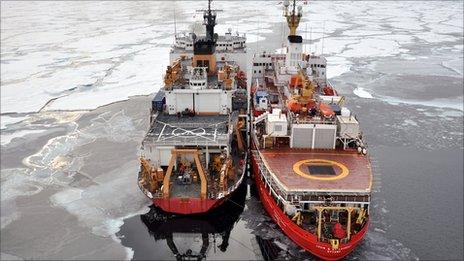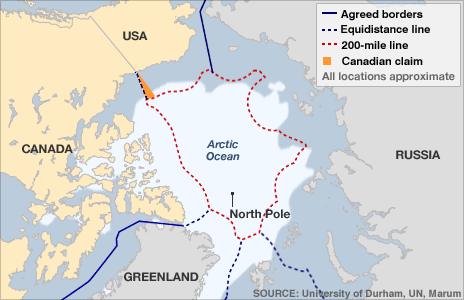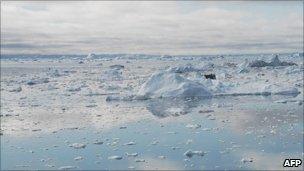US-Canada Arctic border dispute key to maritime riches
- Published

The two countries have conducted previous joint surveys in the Arctic area
Canada and the United States are beginning a five-week joint Arctic survey, part of which will take place in a section of the energy-rich Beaufort Sea that is claimed by both countries.
The survey is intended to help the neighbours determine the extent of their continental shelves.
The bi-national study is part of an ongoing race by the Arctic nations - the US, Canada, Russia, Norway and Denmark - to gather evidence to submit claims under the United Nations Convention on the Law of the Sea (UNCLOS)., external
It could grant them exploitation rights to potential energy and mineral wealth above and below the sea floor.
Currently, coastal nations can claim exploitation rights in an Exclusive Economic Zone (EEZ) - a 200-mile (322km) nautical area beyond their land territory.
If the Arctic nations can prove that their submerged territory extends beyond 200 miles, they could gain access to vast untapped resources which lie beneath the pristine waters of the polar region.
However, a major obstacle for Canada and the US is the uncertainty over how their Arctic maritime boundary should be defined.
"Canada and the United States need this data, both to delineate the continental shelf and to assist in the eventual resolution of the Beaufort Sea maritime boundary dispute," explained Canada's Foreign Affairs minister, Lawrence Cannon, in a press release describing why the two countries were co-operating on this mission.
Treaty claim
UNCLOS, which Canada has ratified and which the US has expressed a desire to ratify, has focused the attention of the two neighbours on their unresolved Arctic boundary, according to Professor Donald McRae of Ottawa University.
"The dispute really only dates from around the 1970s, because until the 200-mile zones came into existence, states paid little attention to maritime boundaries," Professor McRae, also a member of the UN International Law Commission, told the BBC.

The US claimed its 200-mile zone in 1976; Canada in 1977.
But the roots of Canada's claim are historical - based on an 1825 treaty between Russia and Great Britain, the countries which possessed Alaska and Canada in the 19th century.
Russia sold Alaska to the United States in 1867 while Great Britain handed its Canadian possessions to Canada when it became an independent country.
Canada's interpretation of the treaty, written in French, is that the maritime boundary extends north of the Alaska-Yukon border into the sea.
However, the US rejects Canada's claim that the treaty fixes a maritime border. Instead, it bases its claim on the equidistance method, "a line drawn so it is equidistant from the coasts of both parties," explains Professor McRae.
On a map, the resulting overlap in border claims resembles a pie-slice, approximately the size of Lake Ontario - one of North America's Great Lakes, covering a vast area of just over 21,000 sq km.
Pressure to drill
While there was previously no pressure to resolve a border in a remote, icy, inhospitable region, the stakes have increased for both countries with the discovery of vast hydrocarbon deposits in the disputed area.

Melting sea ice is making the Arctic more accessible to shipping and resource exploration
According to figures made available to the BBC by Canada's National Energy Board, the seabed below the disputed area is eye-wateringly resource-rich, containing a potential 1.7bn cubic metres of gas - enough gas to supply Canada for 20 years - and over 1bn cubic metres of oil.
The US has called a moratorium on any American offshore drilling pending a review of the Gulf of Mexico spill while Canada is currently considering bids from companies interested in offshore exploration.
However, no drilling is due to to take place in Canada's Arctic waters until the National Energy Board has completed its review of offshore drilling.
But before any further development can take place, the border question has to be resolved.
Last month, it was revealed that quiet negotiations, a "dialogue of experts", began in Ottawa with the approval of Mr Cannon and US Secretary of State Hillary Clinton. A second meeting is due to take place in Washington next year.
Ironically, says Professor McRae, beyond 200 miles "the Canadian line is better for the US - and the US line better for Canada".
This strange twist could actually be the key to resolving this outstanding border issue - to the great benefit of both parties, according to University of British Columbia law professor and Arctic expert Michael Byers.
"All of a sudden, we have this almost perfect opportunity for a win-win, negotiated solution," said Professor Byers in an interview with the Ottawa Citizen earlier this year.
"Regardless of which method you use [to determine the boundary], each country is going to get a substantial amount of what is the new disputed sector - the perfect recipe for a negotiated compromise".
And with the territory comes access to the huge energy and mineral wealth lying beneath the waters.
- Published28 July 2010